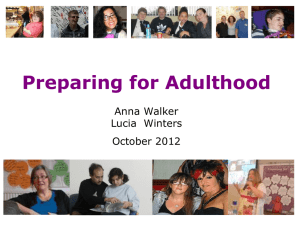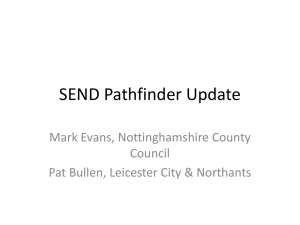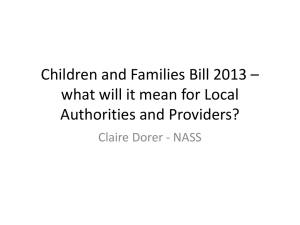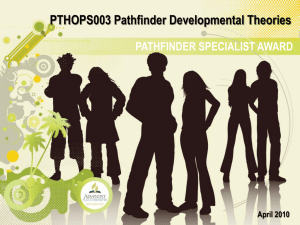14-19 Pathfinders - Education and Employers Taskforce
advertisement
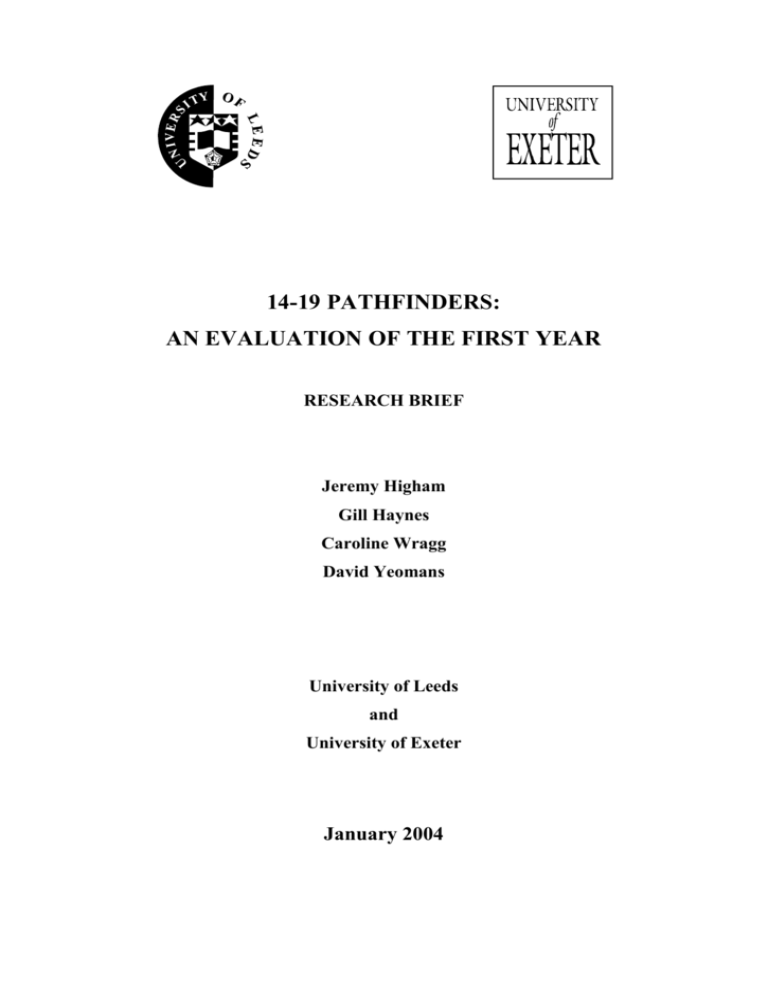
14-19 PATHFINDERS: AN EVALUATION OF THE FIRST YEAR RESEARCH BRIEF Jeremy Higham Gill Haynes Caroline Wragg David Yeomans University of Leeds and University of Exeter January 2004 14-19 PATHFINDERS RESEARCH BRIEF INTRODUCTION This report on the national evaluation of the first year of the Phase One 14-19 pathfinders describes the progress made by the twenty-five Phase One pathfinders and also a number of partnerships not funded through the pathfinder programme and raises key issues from the evaluation. It is important to acknowledge that because pathfinders are still in the relatively early stages of development we report mainly upon intentions, plans and early developments rather than upon changes which had taken place in student experience. However, this early involvement by the national evaluation provides opportunities to describe and analyse the pathfinders as they develop and take shape. The pathfinders are marked by diversity and responsiveness to local aspirations and circumstances. They have made very positive progress in many aspects of development including: the establishment, or strengthening, of extensive collaborative arrangements which provide a strong basis for further development the development of broader curricula offering greater choice and flexibility, especially for 14-16 year olds, mainly involving the provision of vocational and work-related learning in colleges, training providers and workplaces provision for variations in the pace of learning for higher achieving students improvements in the advice and guidance provided to young people approaching, and passing through, the 14-19 phase productive links with other programmes, particularly Increased Flexibility and Excellence in Cities, and further development of strategic planning of the 14-19 phase. THE 14-19 PATHFINDER INITIATIVE The 14-19 pathfinders are part of a larger process of reforming the 14-19 phase of learning encompassing the Green Paper, 14-19: extending opportunities, raising standards, the subsequent consultation and the continuing work of the Working Group on 14-19 Reform. The main aims of the reform process are to: raise the levels of achievement of all young people; meet the needs and aspirations of all young people; broaden the skills acquired by all young people; be delivered through flexible, integrated, innovative networks of collaborative providers. 1 14-19 PATHFINDERS RESEARCH BRIEF The pathfinders are expected to link with a wide variety of other initiatives including Excellence in Cities and Excellence Challenge, Diversity Pathfinders, Enterprise Pathfinders, the Increased Flexibility for 14-16 Year Olds programme, Partnerships for Progression and Entry to Employment. Pathfinders are expected to: test out a range of ideas and discover new ones; develop best practice in 14-19 education and training; see how 14-19 policy will fit with other policies; identify barriers to a coherent 14-19 phase and design ways to overcome them; show that a coherent 14-19 phase can be achieved nationally in a variety of locations with different social circumstances and different mixes of schools and colleges. There were 25 successful Phase One pathfinder proposals. Several pathfinders are based in large urban areas, others have been set up to address issues of rural isolation and deprivation while some are located in mixed urban/suburban/rural areas. Pathfinders also vary in the size of the geographical area covered, the number and types of institutions involved and the extent to which they address the full range of potential 14-19 issues or focus upon selected elements of the reform agenda. The DfES and the LSC each made available £5 million to support the pathfinders in 2002/3. EVALUATION METHODOLOGY The evaluation had four main aims: (i) To assess the extent to which the 14-19 pathfinders have begun to develop best practice in creating a more coherent 14-19 phase at LEA, consortia, institutional and individual levels and to identify a number of models of 14-19 provision (ii) To explore and analyse the opportunities for, and constraints on, the development of the 14-19 phase in the pathfinders and elsewhere (iii) To examine the potential value-added effects of the 14-19 pathfinders and associated funding arrangements (iv) To identify possible approaches to the continued evaluation of the 14-19 pathfinder initiative. Four main methods were used to address these aims: (i) documentary analysis (ii) selective literature review of cognate approaches to educational change (iii) surveys of all Phase One pathfinders in April (n=22) and September 2003 (n=20) (iv) case studies of six pathfinders, three unfunded 14-19 partnerships and shortened case studies of three London pathfinders. 2 14-19 PATHFINDERS RESEARCH BRIEF EVALUATION FINDINGS Overview of progress Pathfinders were asked to assess the extent of progress made towards their objectives grouped by theme or to state that the theme was not an objective. The areas in which they reported greatest progress were: collaboration; developing broader curriculum offerings; extending work-related programmes and targeting a range of young people. Areas which were most commonly not included as objectives were: developing post-16 access to key skills; overcoming gender/ethnicity differences in young people’s choices. Areas in which there was less than expected progress reported in more than three pathfinders were: providing enhanced advice and guidance; developing individual learning plans. Organisation of the pathfinders The development of institutional collaboration emerged as a significant area of advancement, with all responding pathfinders reporting as expected or better than expected progress. Collaboration varied considerably across pathfinders in relation to the extent of institutional involvement in partnerships and the scale, scope and intensity of collaboration. Rural pathfinders faced particular collaborative challenges, related to the costs and time of travel. They were exploring various ways of meeting these, including the development of elearning and moving staff rather than students between institutions. Collaboration in urban pathfinders was facilitated by relatively easy transport and the accessibility of comparatively large numbers of schools, colleges, training providers and employers. Strategic partnership working in some urban areas however, could be hindered by local authority and other boundaries. Partnerships which had not received pathfinder funding also developed collaboration, often promoted by the Increased Flexibility programme. However, in these unfunded partnerships and in the pathfinders, there was agreement that pathfinder funding enabled collaboration to develop more quickly and be more effective, especially through supporting managerial and development time. The funding of work-related, vocational courses in colleges and through training providers, especially for 14-16 year olds, emerged as a key issue in the evaluation. These courses were mainly paid for through a wide variety of short-term funding streams, including pathfinders. Collaborative provision also incurred other expenditure including transport and managerial and administrative costs. Pathfinders had generally not quantified the true costs of collaborative provision. There were widespread concerns among pathfinders about the sustainability of the collaborative provision in the absence of dedicated project funding. 3 14-19 PATHFINDERS RESEARCH BRIEF Pathfinders linked closely with other initiatives, especially the Increased Flexibility programme. Excellence in Cities also supported pathfinder initiatives. Ofsted/ALI area-wide inspections and the funding used to support post-inspection action plans also promoted pathfinder objectives and helped to drive 14-19 reform. Curriculum provision and development A major and successful area of pathfinder development was in the provision of broader curriculum offerings. The growth of work-related vocational courses, wholly or partly provided in colleges, was a particularly significant development and provided greater choice and flexibility for students. Training providers and employers were also sometimes involved in these courses. Some of the courses led to GCSEs in vocational subjects, others to NVQs or other vocational qualifications. Some pathfinders established comprehensive, out-of-school provision for groups of disaffected or disengaged students thought to be at risk of exclusion or self-exclusion. Broadening the curriculum was sometimes inhibited by a range of factors including: lack of funding; lack of capacity by providers; lack of parity between vocational and academic qualifications; concerns about quality of provision; potential effects upon school performance tables; lack of appropriate qualifications and absence of adequate staff training and development. Developments in variations in the pace of learning were reported by most pathfinders. These were almost exclusively related to accelerating the learning of more able students at both level 3 and level 4. There was little evidence of provision for slower learners. Access to key skills at post-16 was one of the least addressed aspects of the pathfinder initiative, with half of the pathfinders indicating that this was not among their objectives. Work-based pathways, incorporating Student and Modern Apprenticeships, had been developed in several pathfinders. However, overall, work-based learning had not achieved a high profile within pathfinders. Introducing or increasing Modern Apprenticeships was reported as not being included among the objectives in 10 pathfinders. There was evidence of rapid recent progress in the area of enterprise capability in some pathfinders, although six reported that this was not amongst their objectives. Enterprise pathfinders had helped to promote activity, although there were some concerns about lack of coherence in initiatives in this area of development. Several pathfinders were using labour market information to identify local skills gaps and provide a basis to establish particular vocational pathways. In other pathfinders however, the establishment of new vocational pathways received little attention, instead emphasis was placed on encouraging students to access existing pathways. 4 14-19 PATHFINDERS RESEARCH BRIEF Targeting young people A high proportion of pathfinder developments, especially in relation to work-related learning, were targeted at disaffected/disengaged/lower achieving pupils. There was also significant emphasis on accelerated learning for higher achieving students. A few pathfinders targeted provision on young people with severe/moderate learning difficulties and some included special schools in their collaborative arrangements. There was, however, a notable lack of targeting of pathfinder developments on students in the middle of the achievement range. The majority of responding pathfinders indicated that they had not included overcoming gender/ethnicity differences in young people’s choices among their objectives. However, pathfinder activities were likely to impact differentially on male and female students and on particular ethnic groups. Many pathfinders had made extensive arrangements to consult young people on proposed developments. Methods described included questionnaire surveys, focus groups, school councils, attendance of young people at pathfinder steering group meetings, interviews at parents’ evenings and other events. Young people interviewed by the evaluation team welcomed greater curricular choice, greater information and increased flexibility to specialise, they disliked curricular compulsion. They were generally responsive to opportunities to study in locations away from their home institutions. Many tended to think less in terms of pathways and destinations than in selecting interesting options at which they believed they could succeed. Supporting young people The importance of enhanced advice and guidance for young people undertaking the 14-19 phase was widely recognised. There was also recognition of the need for partnerships between schools, colleges and Connexions in providing this advice and guidance. There were variations in the ways in which such partnerships were being developed and the reported effectiveness of arrangements. Connexions was playing an effective role in many pathfinders, but given its broad remit and finite resources there was potential tension between the requirements to both support young people most in need and provide universal support. Schools also varied considerably in their capacity to fulfil increased demands for advice and guidance. The development of individual learning plans was uneven across the pathfinders. Most were still in the relatively early stages of development, some were integrating with Progress File developments. There were some innovative approaches to the development of electronic individual learning plans. 5 14-19 PATHFINDERS RESEARCH BRIEF ISSUES FOR POLICY DEVELOPMENT Key questions which have emerged from the evaluation include: To what extent are pathfinders addressing the whole 14-19 phase? The evidence strongly indicates that pathfinders have tended to prioritise the 14-16 age range rather than address 14-19 as a coherent phase. To what extent are pathfinders aiming to change the experience of all young people 14-19? Pathfinders are tending to focus on disaffected/disengaged/lower achieving students and, to a lesser extent, on higher achieving students. Students in the middle range of achievement are far less likely to be affected by pathfinder developments. Within local areas what capacity is there to provide strategic direction to the 14-19 reform agenda, including the operation of pathfinders? Collaborative pathfinder arrangements require careful nurturing and direction and exist within complex local policy environments in which individual institutions have considerable autonomy and in which strategic leadership often needs to be exercised through persuasion and the establishment of common interests. How can developments begun under pathfinders be sustained? The sustainability of pathfinder developments may depend not only upon constancy in national policy and adequate funding, but upon the collaborative and curricular principles of pathfinders becoming embedded in the values and practices of institutions and practitioners. They must also engage the interests of students and influence their choices and behaviours. Is there sufficient capacity to provide the quantity and quality of advice and guidance required? Effective advice and guidance will depend upon strong partnerships being developed between Connexions and the institutions within which young people are enrolled. It will also require that those providing advice and guidance have knowledge and understanding both of the options available to young people and the different ways in which they make decisions about their learning careers. Are pathfinders doing enough to promote participation in work-based learning and improve its quality? Difficulties in establishing a high quality work-based learning route which can meet targets for participation, retention and achievement have been long recognised. There may be scope for pathfinders to do more to promote and improve the work-based route, establish credible pathways and raise the status of work-based learning. 6 14-19 PATHFINDERS RESEARCH BRIEF FUTURE EVALUATION The national evaluation of 14-19 pathfinders will extend its work in 2003/4 to the Phase Two pathfinders. Evaluation work will continue with the Phase One pathfinders. A similar combination of evaluation methods including documentary analysis, surveys of all pathfinders and case study work will be used. Evaluation will also continue in some unfunded partnerships. Pathfinders are also making arrangements for their own local evaluations, often using higher education institutions. These evaluations will be responsive to local needs in their foci, approaches and reporting. However, where it is deemed appropriate by individual pathfinders, it may be worthwhile to develop arrangements through which evaluation findings can be shared. There may be particular aspects of the pathfinders, as they develop, which are worthy of more focused evaluation than can be provided through the current national and local evaluations and which require additional arrangements. 7
